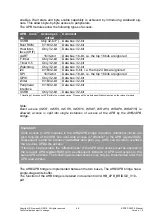
Copyright © Siemens AG 2016. All rights reserved
49
ERTEC 200P-2 Manual
Technical data subject to change
Version 1.0
Figure 7:
AHB/APB bridge, block diagram
The key features of the bridge are as follows:
On the AHB side the AHB_APB_Bridge fully supports the AMBA 2.0 AHB protocol. It
only uses the AHB-Lite subset of this protocol. The bridge is connected on the AHB-
Layer as a slave.
On the APB side the AHB_APB_Bridge supports the AMBA 2.0 APB protocol. Ac-
cesses on the AHB side are one by one translated into APB accesses, write accesses
are handled as posted, i. e. AHB_
APB_Bridge completes the access on the AHB side as soon as it is able to start it on
the APB side.
The AHB_APB_Bridge is not able to produce back-to-back accesses on the APB side.
In difference to the APB specification it uses an IDLE state after every APB access
even when there already is an AHB access waiting to be translated. AHB bursts are
treated as sequences of single accesses.
Expanding the AMBA 2.0 - APB specification, the AHB_APB_Bridge provides the
option of using a variable timing of APB accesses. By introducing a ready signal, wait
states can be implemented. The standard AMBA-APB bus is expanded by the PRDY
sideband signal (see Figure 8: APB bridge, timing with sideband signals PRDY and
PBE).
Expanding the AMBA 2.0 - APB specification, the AHB_APB_Bridge provides the
option of using "byte enables" on APB bus. Therefore the standard AMBA-APB bus is
expanded by the sideband signals PBExx which exist in parallel to PADDR, i.e.
PADDR and PBE timing are identical (see Figure 8: APB bridge, timing with sideband
















































